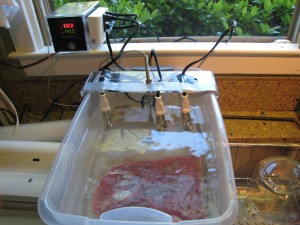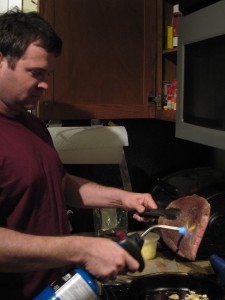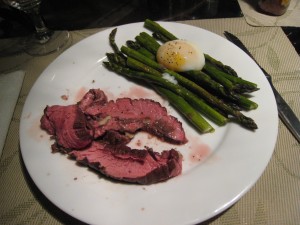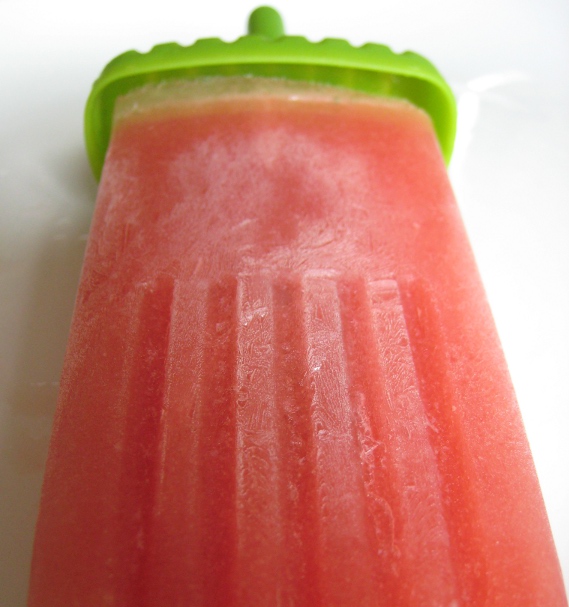Carrie Schleiffer is a short, formidable woman in food-spattered whites. She began the meal like this:
There’s really no other way to say this, these are lamb balls.”
And we’re off…
G2B is a weird place in the way that a lot of RDU restaurants are weird. It’s slightly remote, tucked into ugly strip-mall real estate (it shares a non-descript office building with Wells Fargo, and some kind of extreme powerlifting gym) and it’s slightly more trendy in decor and furniture than either the town or the location. It’s an ambitious place to be running in this economy; like a lot of restaurants they could probably always use more business than they’re getting. So, events like a “Nose to Tail Beer Dinner” make a certain amount of sense. Get a dozen people prepaid at $60 apiece on a Wednesday night and there’s a good chance you’ll make your nut for the evening.
My friend Andrew is a graduate student in the Religious Studies department at UNC and grew up in his families restaurant business so he was the perfect choice of companions. (Oddly, the only other time I’d eaten animal testicles it was with Andrew as well, a Rocky Mountain Oyster burger at Bull City Burgers in Durham.)
So, here’s the rundown of the five courses and five beer pairings we consumed over the course of about three hours.Â
Chef’s Amuse: Lamb Fries with Harrisa Ketchup
I was a little surprised at the crowd, honestly; they weren’t the usual folks I tend to run into at local food events and at least one pair was extremely atypical, more there for the beer than the food. The male half of the couple had actually never eaten *any* of the organ meats on the evening’s menu before. Which was nice because with the amuse served family-style, I got most of his lamb testicles.
Lamb’s nethers are more delicate than beef, less rubbery and not quite as musky. There’s still a particular sort of animal umami to them though, that off the beaten track funk that clam bellies have. Regardless, battered in panko and deep-fried if you served them without comment at a child’s birthday party the kids would eat them without complaint.
Alongside were some very nice breads, a dark rye and a poppy-seeded white and after trying the butter I was tempted to sneak the crock into my pocket on the way out. It was a blend, half cultured butter, half whipped Tuscan-style cured Lardo, slices of raw pig fat that had been brined and cured in spices and garlic. Amazing stuff; if common sense hadn’t prevailed I might have died of gluttony eating the bread basket and never made it to the rest of the courses. It was an auspicious beginning to the meal.
1st Course: Pig’s Head Salad with Sunny-Side Up Quail Egg
Beer: FullSail Brewing, Brewer’s Share “Chris’s Summer Delight” Berliner Weiss
Surprisingly enough there wasn’t a lot of salad to this salad, just a few pieces of frisee and radicchio weighed down by a lot of smoked and unsmoked pork products. I found that a bit of a cheat actually as there were applewood-smoked bacon lardons scattered with the bits of cheek and ear from the pig’s head; the extreme smokiness of the bacon made it harder to enjoy the milder cuts. Still, there’s no better sauce than just-warmed egg yolk, and hey, it’s a salad so it’s healthy!
I’m not usually a beer guy but I have to admit that every beer served during the evening was unique to my experience and fantastic with the food. The Berliner Weiss is a German summer brew, a weissbeer cut with a little bit of ascorbic acid. That gives it a hint of a citrus tang without the actual fruit, just enough of a bite to lift the fat off your tongue and leave you feeling refreshed and ready for the next bite of food. Good stuff.
2nd Course: Offal&Foie Gras Terrine, braised bitter greens with house-cured guanciale, red wine whole-grain mustard
Beer: Brooklyn Brewery “Sorachi Ace” Belgian-Style Saison
Terrines were often repositories for the floor-sweepings and fridge-cleanings of the kitchen, the Garde Manger’s last ditch attempt to make money out of what would otherwise be garbage. The chef honored that with this course, incorporating heart, lung, liver, and kidney into the mix, along with that single teasing nugget of foie gras in the center. Eating it with the terrine would have been a waste; both Andrew and I dug it out and smeared it on the baguette by itself. After that the terrine was, well, terrine, meaty, good with the mustard and the greens, but as with some other cold dishes there wasn’t much memorable about the flavors. Given the contents that might be considered a success rather than a failure. And with the mustard-greens and mustard it would have made a tidy little lunch. (The mustard was so good I actually ate it with a fork after the terrine was gone; was it just mustard seeds soaked in red wine? Need to look into that…)
Of the beers this was my least favorite, a complex heavy golden with that was too overspiced with grains of paradise for my taste. As a pair with the terrine it worked though, adding additional degrees of flavor to the slightly underseasoned meats. Not a bad beer, just not something I’d drink on its own.
3rd Course: Tongue and Cheek: Duo of corned beef tongue “sandwich” with a beef cheek confit French onion soup.
Beer: Green Flash and Brasserie St. Feuilllien “Frendship Brew” Dark Spiced Ale
There was really nothing not to love here. The tongue was cured to almost a meat butter that disintegrated under the fork. The bit of gruyere cheese and the rye bread crisp were nice touches but they weren’t necessary. The French onion soup was very good French onion soup, just with a tender little chunk of beef confit at the bottom. It was a little gristly actually, but with the soup being so good it was almost an afterthought. Both portions were small (we were three and a half courses and four drinks in at this point) but served as a full-sized portion this would be the ultimate winter evening dinner, the food equivalent of sprawling on a bearskin rug naked in front of a roaring fire.
This firey-nakededness feeling was enhanced by the beer, my favorite of the night. Dark but not heavy, and with just enough sweetness and spice to make it interesting, it was the only glass I actually finished during the evening. The staff was pouring full-sized portions of each beer and I’m a lightweight; by round three I was starting to feel it a bit.
4th Course: Sweet Spiced & Beer-Braised Oxtail with Veal Sweetbreads, sweet potato puree, Caramelized Brussels Sprouts, hen of the woods mushrooms
Beer: Nogne 0 and Terrapin Beer Co. Imperial Rye Porter
Whoof…I was getting tired (and tipsy) by this point, but it would have been a shame to give this course less attention. The oxtail was off the bone, a pile of buttery-soft shredded meat that had been spiced with a little bit of heat in the mix, just enough to sneak through the sweet potato and nip at your tongue through the richness. The brussel sprouts worked in a similar way, the bitter adding an additional wake-up call. The mushrooms were a nice addition but not really necessary; there were so many other strong flavors at play they mostly got lost in the shuffle. Still, it was a very pretty plate and a delicious one, another dinner I’d order as a full-sized plate in a heartbeat. A cholesterol-clogged, struggling, heartbeat.
The beer was described as the Cabernet Sauvignon brew of the evening and it *was* heavy, a little much after the other three and the food, but still tasty. The Rye malt is an interesting addition, adding a sense of heat to the beer, almost like tannins would in a wine. Again, probably not something I’d drink alone but with food it balanced rather nicely.
Dessert: Meyer Lemon Shaker Pie, Reisling-Poached Pear, Pickled Persimmons, Graham Cracker, and Goat’s Milk Sorbet.
Beer: Shandy 2.0 Fullsteam Brewery “El Toro” Cream Ale with Meyer Lemonade and Hop Simple SyrupL
After all that savory food you’d think dessert would have gone forgotten but honestly this was an absolutely amazing course, completely reinvigorating my enthusiasm. I’d never had Shaker Lemon pie before, and I can’t say it wowed me; bits of chewy lemon peel macerated in sugar in a slightly over-thick shortbread crust. Still, the lemon was the perfect flavor after all the fatty food, and there was an additional smear of what seemed to be Meyer Lemon foam/mousse that was delicious in the same way. The pears were chopped rather than whole, which strikes me as a much more elegant and exciting way to prepare and eat them; I’d devour any amount you wanted to give me, over ice cream or by themselves. The goat’s milk sorbet melted into them, giving a little bit of a gamey tang to the sweetness of the fruit and sugar. I need to find out how they pickled the persimmons; they were at just the last minutes before being fully ripe which meant that there was still the slightest hint of tannins left, just enough to slap you awake. Not listed on the menu but also delicious was a tiny petit-four cakelet, a layer of what seemed like goat-milk panna cotta on a dense white cake. Pale, light, and not heavily seasoned in any way by itself, it went really well with the various fruits.
The Shandy was the final beer of the evening but it was also the best in show, the perfect pairing prepared in the perfect manner. Shandys are summertime beers, an ale or lager cut with equal parts lemonade, light enough to drink all afternoon. This was light enough, but they’d taken it a step further with the Meyer Lemonade, sweetening it with simple syrup they’d infused with hops. That added one more level of complexity to the mix, plus just a titch more bitterness, another one of those olfactory and taste alarm clocks. The more I think about it, those little palate-cleansing tripwires really were one of the most impressive aspects of the meal and this beer was the last, and possibly best, example.
And that was it. Schleiffer and the beer steward took their bows (at our applause, she gave a dismissive wave and said “It’s just food, guys.” I like her.) and after settling up the bills we were out. G2B is a bit out of the way but it’s a ballsy little attempt at something and its heart is in the right place. (As are its liver, kidneys, lungs, and tails.) I’ll definitely be keeping an eye on them in the future.




